In a rural village at the Southwest corner of the Isaan Plateau, just over an hour drive south of Thailand’s second largest city, Korat, a band of tenacious permaculturalists have just arrived at the site of their new home. Over the course of the next year, infrastructure will be erected, community and teaching spaces will be established and a traditional corn and rice farm will undergo a dramatic metamorphosis. The work here has already begun… and I’d like to take you along for the ride!
We arrived on site on a warm mid-January afternoon full of excitement and anticipation. What wonders awaited us on this amazing new permaculture adventure?
Our Sala
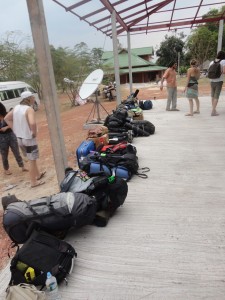
The Sala, a steel and concrete shell of a structure that will eventually become our educational facility, common areas and community kitchen, basically consists of a foundation and partially finished tile roof. Open on all sides, the Sala has a long way to go before it’s ready for it’s first PDC. Even as I type, the final tiles to complete the Sala roof are being installed. Soon we’ll fire up the Compressed Earth Brick (CEB) machine and begin pressing bricks. The CEBs will comprise the exterior walls of The Sala and several other structures such as student dorms, showers and private bungalows for longer term residents. All part in parcel of establishing the infrastructure for a Permaculture education center.
Our Community
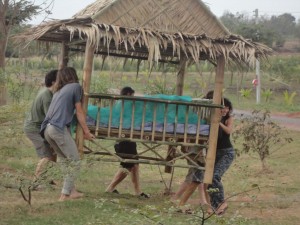 More important even than constructing the physical infrastructure of a permaculture education center is the task of building the community infrastructure. On this important task, we got to work right away. Aside from several “get-to-know-you” activities, our first real team-building excursive came about organically. Several handmade bamboo bungalows had been built in anticipation of our arrival. Establishing our sleeping arrangements for the first evening was a high priority… and what better place to sleep than overlooking one of several beautiful fishponds on site? As several people teamed together to arrange the bungalows along the water’s edge, another group coordinated to set up comfortable kitchen, dining and meeting spaces.
More important even than constructing the physical infrastructure of a permaculture education center is the task of building the community infrastructure. On this important task, we got to work right away. Aside from several “get-to-know-you” activities, our first real team-building excursive came about organically. Several handmade bamboo bungalows had been built in anticipation of our arrival. Establishing our sleeping arrangements for the first evening was a high priority… and what better place to sleep than overlooking one of several beautiful fishponds on site? As several people teamed together to arrange the bungalows along the water’s edge, another group coordinated to set up comfortable kitchen, dining and meeting spaces.
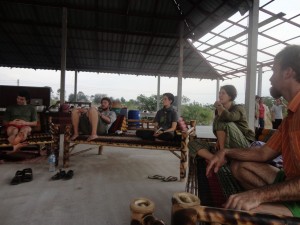 After getting more aquatinted with our new space, we sat down for the first meet-and-greet meeting. Around the circle we went, each saying our name and telling a little bit about ourselves and what got us to this project.
After getting more aquatinted with our new space, we sat down for the first meet-and-greet meeting. Around the circle we went, each saying our name and telling a little bit about ourselves and what got us to this project.
As the day grew long we briefly toured the farm before finally settling down to a freshly cooked meal courtesy of our Thai family hosts. I can only speak for myself, but I’m sure I was not the only person that went to bed awestruck that evening. By any standard of measure, this is going to be one incredible year!
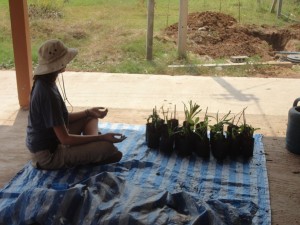 Up early the next morning we got right into the swing. We broke ourselves into teams and agreed upon a protocol for chores and cooking schedules. Our priorities for the day were establishing a temporary nursery, gathering supplies and further organizing our personal and community spaces.
Up early the next morning we got right into the swing. We broke ourselves into teams and agreed upon a protocol for chores and cooking schedules. Our priorities for the day were establishing a temporary nursery, gathering supplies and further organizing our personal and community spaces.
Many runs to and from town to gather truckloads of various essentials were interspersed with several fun activities and games that helped us to learn more about each other and build our community spirit. The bits and pieces were starting to fall into place and the excitement only continued to build.
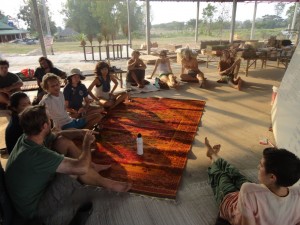 In afternoon we dusted off the old white board and gathered together to further our progress on invisible structures. Establishing agreements that would form the foundation of our community and provide us a structure for organizing ourselves to accomplish all our personal, professional and project goals.
In afternoon we dusted off the old white board and gathered together to further our progress on invisible structures. Establishing agreements that would form the foundation of our community and provide us a structure for organizing ourselves to accomplish all our personal, professional and project goals.
Another incredibly productive day, and the week had only just begun. Our systems were becoming more streamlined, our community feeling more comfortable and our visions more unified. Permaculture in Thailand is taking it’s next big leap forward and the opportunities are growing ever more abundant. But, as we would soon find out, dry season in the tropics comes with it’s challenges…
“Dry” Season in the Tropics
Our first week in the tropical beauty of Central Thailand had only just begun. Already so much had been accomplished and the community was feeling highly spirited about the road ahead. We knew challenges would await us… but we didn’t realize just how emanate those challenges were.
 Water is a very crucial element in permaculture design. Arguably, it could be considered the most crucial. Perhaps that is part of the reason it is often listed as the first element to consider in the design strategy known as “mainframe design” (a design strategy that prioritizes the three mainframe elements of water, access and structures).
Water is a very crucial element in permaculture design. Arguably, it could be considered the most crucial. Perhaps that is part of the reason it is often listed as the first element to consider in the design strategy known as “mainframe design” (a design strategy that prioritizes the three mainframe elements of water, access and structures).
Naturally, water was a first priority for our temporary kitchen space in The Sala. This meant digging well over 100 meters of trench through solid clay. Permaculture is often glamorized as a lazy, “sit in the hammock all day and watch the garden grow” kind of experience. Personally, I’ve spent far more time digging holes and trenches than lazing in a hammock. Many hands make light work, however, and digging a trench can be a very fun and gratifying community exercise. In the modern world, we often seek satisfying and meaningful work… This is what permaculture is for me — even when it involves digging trenches.
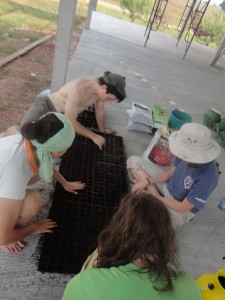 After a healthy amount of our physical energy was expressed at the end of a hoe we engaged in the slightly less intensive task of expanding our temporary nursery. Basil, peppers, eggplant and many other warm weather crops are beginning to sprout. We’re also germinating several leguminous support trees in anticipation of the coming planting season. Between the months of June and July, the weather in this part of the tropics turns to monsoon conditions. Its not the most accommodating conditions for building or earthmoving but it’s the optimal time to establish gardens and start planting out food forests.
After a healthy amount of our physical energy was expressed at the end of a hoe we engaged in the slightly less intensive task of expanding our temporary nursery. Basil, peppers, eggplant and many other warm weather crops are beginning to sprout. We’re also germinating several leguminous support trees in anticipation of the coming planting season. Between the months of June and July, the weather in this part of the tropics turns to monsoon conditions. Its not the most accommodating conditions for building or earthmoving but it’s the optimal time to establish gardens and start planting out food forests.
Subtropical weather
Currently, we are in the midst of what is supposed to be the region’s driest time of year. Average precipitation for January is less than 6 millimeters rising only slightly to just over 17 millimeters in February (still less than three quarters of an inch).
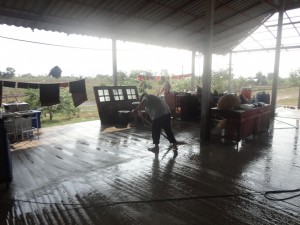 Being the best time of year to set up physical infrastructure, the plan was to arrive in the dry season, begin making adobe and compressed earth bricks and start building. It seems 2012 had a different plan for us altogether.
Being the best time of year to set up physical infrastructure, the plan was to arrive in the dry season, begin making adobe and compressed earth bricks and start building. It seems 2012 had a different plan for us altogether.
A serious challenge to the resilience of our new community came on only the third night when an unexpected storm blew through The Sala. Winds blew rain horizontally, saturating so much our hard work as we huddled together behind a makeshift barricade.
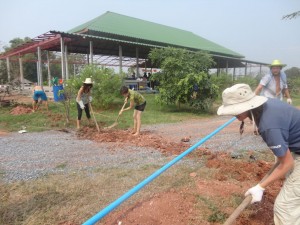 In the morning, we assessed the damage, dried ourselves off and took the opportunity to further organize and better arrange our systems. As a testament to the community work we had done over the previous few days, spirits were still quite high and some of us even felt more energized, after all… the wet soils made digging the trench for our water line far easier!
In the morning, we assessed the damage, dried ourselves off and took the opportunity to further organize and better arrange our systems. As a testament to the community work we had done over the previous few days, spirits were still quite high and some of us even felt more energized, after all… the wet soils made digging the trench for our water line far easier!
A Very Soggy Permaculture Education
That night, we were confronted again with heavy gusts, thunder, lightning and, for the open bamboo bungalow, devastating horizontal rains. By morning, most people had retreated to the safety of the Sala, pitching their tents or creating storm shelters out of bamboo furniture, cushions and spare blankets. Much to our amazement, the wind direction seemed to completely mirror the storm from the previous evening. So all the preparations we made for windbreaks were of no significance. Again, we were saturated.
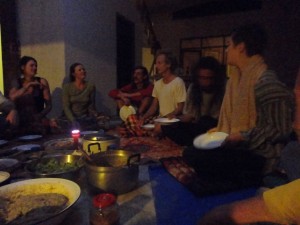 Due to an unusual set of weather patters, the past week has resulted in well over a foot of rain with still more forecasted. With planning and quick reactions we’ve become more resilient to these unexpected anomalies and our community still finds space (under cover) to flourish.
Due to an unusual set of weather patters, the past week has resulted in well over a foot of rain with still more forecasted. With planning and quick reactions we’ve become more resilient to these unexpected anomalies and our community still finds space (under cover) to flourish.
Our focus can now move ahead into the coming weeks as we prepare for our first Permaculture Design Course to be held on site. Establishing weather proof shelters for students has obviously risen to the top of our priority list. Fortunately, the experience of this past week has given us the foresight to not only recognize the importance of preparing for the unexpected but also the allowed us to see the many opportunities available to meet these challenges.
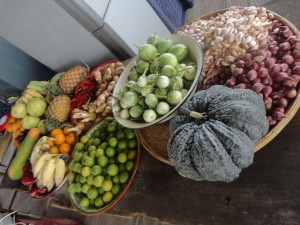 As luck would have it, good food and meaningful work can go a long way in community. Despite the unexpected challenges, we’ve made significant progress in only one short week here at Thailand’s newest permaculture farm and education center. Many more exciting challenges and adventures are just around the corner. I hope that you can join us as we leap into this new year of growth and discovery!
As luck would have it, good food and meaningful work can go a long way in community. Despite the unexpected challenges, we’ve made significant progress in only one short week here at Thailand’s newest permaculture farm and education center. Many more exciting challenges and adventures are just around the corner. I hope that you can join us as we leap into this new year of growth and discovery!

Try http://www.permacultureinstituteofthailand.org for more places to visit.
correction: http://www.permacultureinstitutethailand.org
That should be http://www.permacultureinstitutethailand.org